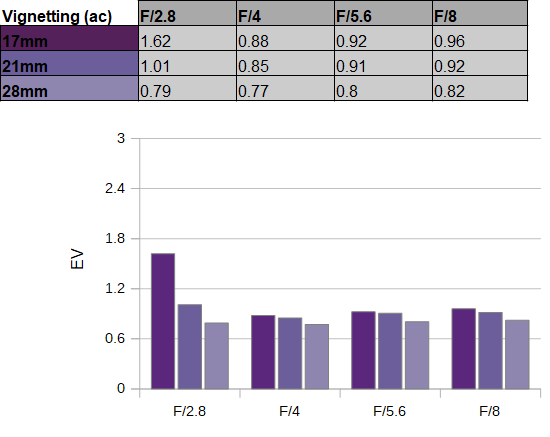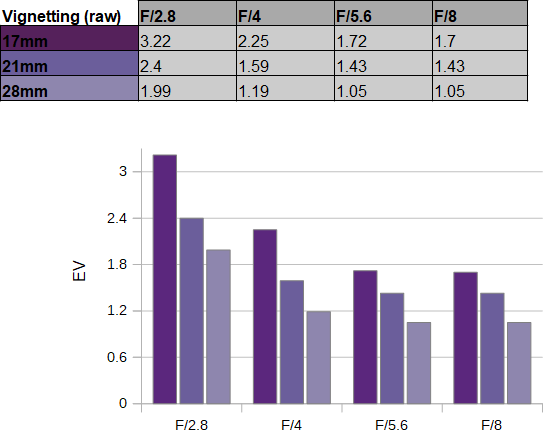|
Tamron 17-28mm F/2.8 Di III RXD - Review / Test Report - Analysis |
|
Lens Reviews -
Sony Alpha (Full Format)
|
|
Page 2 of 3

Distortion
With activated image auto-correction, you don't really have to worry about image distortions. They are near-zero as you can see below.
When looking at the RAW characteristic, things don't turn as sour as you might expect if you have followed our mirrorless lens reviews over the years. The distortion figures remain very moderate with just slightly elevated figures at the extreme ends of the zoom range.
Vignetting
In standard shooting mode - thus with activated image auto-correction - the vignetting is fairly well controlled. You will still be able to spot some light falloff - just shy of 1EV (f-stops) in many scenes. The only exception is 17mm @ f/2.8 where the vignetting exceeds 1.6EV (f-stops).
 The effects of auto-correction can be easily observed when comparing the above with the RAW figures. The original vignetting is rather extreme at 17mm f/2.8 and > 3EV (f-stops). That's even beyond our usual scale for full-format lenses. Stopping down helps, but a minimum vignetting of 1.7EV isn't glorious at 17mm f/8. The situation eases the more you zoom out but the vignetting remains an issue at f/2.8 at least. That all being said - keep in mind that ultra-wide lenses are always producing higher vignetting compared to lenses with longer focal lengths.
The effects of auto-correction can be easily observed when comparing the above with the RAW figures. The original vignetting is rather extreme at 17mm f/2.8 and > 3EV (f-stops). That's even beyond our usual scale for full-format lenses. Stopping down helps, but a minimum vignetting of 1.7EV isn't glorious at 17mm f/8. The situation eases the more you zoom out but the vignetting remains an issue at f/2.8 at least. That all being said - keep in mind that ultra-wide lenses are always producing higher vignetting compared to lenses with longer focal lengths.

MTF (resolution at 42 megapixel)
The most interesting aspect is, of course, sharpness. Tamron decided to implement a rather short zoom range (~1.7x zoom ratio) so you may expect that the quality is very high. This is true to a certain degree here but it doesn't tell the whole story. The lens performs best in the extreme wide to mid-range - which is good. After all, you probably don't buy this lens for its 28mm setting. At 17mm, the center quality is excellent straight from f/2.8. The border quality makes it just across what we define as "very good" at f/2.8 - which is commendable - and it becomes slightly better at medium aperture settings. The corners are acceptable at f/2.8, but the quality increases nicely towards a good to very good peak between f/5.6 and f/8. The results are somewhat better still at the 21mm setting with no real weakness even at f/2.8. The situation changes at 28mm though. The center quality remains very high but the outer image field is a bit soft at f/2.8 and f/4. However, there's a boost in quality at f/5.6 and f/8 with pretty sharp borders/corners. Diffraction has a fairly high impact at f/11 at all focal lengths, so unless you need the extra depth-of-field you should stay below this setting.
The field curvature is minimal. The centering quality of the tested sample was good.
Please note that the MTF results are not directly comparable across the different systems!
Below is a simplified summary of the formal findings. The chart shows line widths per picture height (LW/PH) which can be taken as a measure for sharpness.
If you want to know more about the MTF50 figures you may check out the corresponding Imatest Explanations

Chromatic Aberrations (CAs)
Once again - on Sony cameras, you don't really have to worry about chromatic aberrations due to image auto-correction. The RAW CAs aren't brilliant at f/2.8 with a peak beyond 1.7px on the average at the image borders. Stopping down reduces the CA at f/4 already and the results are good at medium aperture settings.

Bokeh
For practical reasons, we usually don't perform formal bokeh tests with ultra-wide lenses but some sample crops below may give you an impression of what the lens can give you in real life.
Surprisingly, highlights are very nicely rendered for an ultra-wide lens. The circular shape remains intact across most of the image field. The discs show only a minor degree of outlining and the inner zone is just slightly nervous. We've seen a lot worse in this class, for sure.
 As far as the general rendering is concerned, things aren't quite as impressive with very distinctive "halos" at harsh contrast transitions. However, keep in mind that most ultra-wide lenses struggle in this respect.
As far as the general rendering is concerned, things aren't quite as impressive with very distinctive "halos" at harsh contrast transitions. However, keep in mind that most ultra-wide lenses struggle in this respect.

|